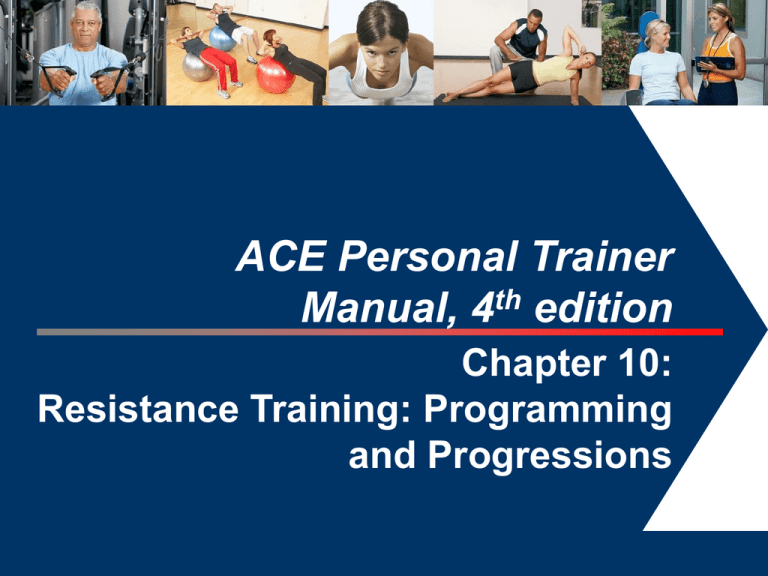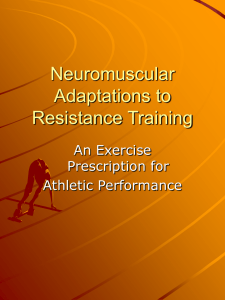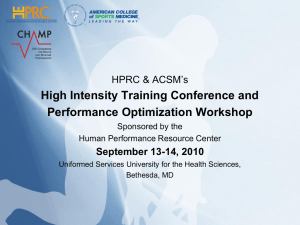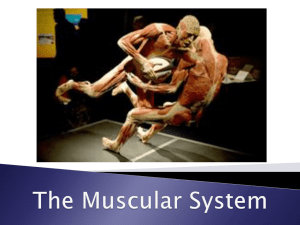Resistance Training
advertisement

ACE Personal Trainer Manual, 4th edition Chapter 10: Resistance Training: Programming and Progressions 1 Benefits of Resistance Training The primary outcome of regular resistance exercise is an increase in muscle fiber size and contractile strength. Secondary outcomes include increased: – Tensile strength in tendons and ligaments – Bone mineral density (BMD) Other potential benefits include: – Increased physical capacity – Improved physical appearance and body composition – Enhanced metabolic function – Reduced injury risk – Disease prevention Physiological Adaptations to Resistance Training There are two principal long-term physiological adaptations to progressive resistance exercise: – Increased muscular strength – Increased muscle size (hypertrophy) Myofibrillar hypertrophy (contractile) versus sacroplasmic hypertrophy (non-contractile) Motor learning – During the first several weeks of training, strength gains are largely the result of neurological factors (motor learning). – Repeat performances of a resistance exercise result in more efficient activation of the motor units involved in the exercise movement. Factors That Influence Muscular Strength and Hypertrophy Hormone levels – Growth hormone and testosterone Gender Age Muscle fiber type Muscle length Limb length Tendon insertion point Muscular Strength/Power/Endurance Relationships Muscular strength Muscular endurance Muscular power The relationship between the exercise weightload and muscular power is somewhat complex. Training Variables The design of effective programs requires consideration of several factors and programming variables, including: – A thorough needs assessment on the client – Appropriate exercise frequency consistent with the client’s goals, training experience, current conditioning level, and necessary recovery periods between sessions – Appropriate exercises and exercise order consistent with program needs and goals, equipment availability, and client experience, technique, and conditioning level – The exercise volume and load—sets, repetitions, and intensity – The appropriate rest intervals between sets selected according to the client’s needs and goals Needs Assessment The trainer must identify the physiological parameters needed to achieve success with respect to the client’s goals. To complete the needs assessment, the trainer should consider the following: – Movement analysis – Individual assessment Training Frequency Training frequency is inversely related to both training volume and training intensity. New exercisers should perform resistance training two or three days a week for best results. Advanced exercisers who perform high-volume/high-intensity strength workouts should not train the same muscle groups more frequently than every third day. Exercise Selection and Order Exercise selection and order is a complex process that requires consideration of: – The individual’s experience and exercise technique – Movement and physiological demands of the activity or sport – Equipment availability – Time availability Trainers can select from a variety of methods to enhance muscle conditioning: – Performing primary exercises followed by assisted exercises – Alternating upper- and lower-extremity exercises – Grouping pushing and pulling muscles within a session – Alternating pushing and pulling movements – Performing supersets or compound sets with little or no rest between them The following slide provides an example of an appropriate exercise progression. Appropriate Program Progressions Training Volume Training volume is calculated in several ways: – Repetition-volume calculation: • – Volume = Sets x Repetitions (for either the muscle group or the session) Load-volume calculation: • Volume = Exercise weightload x Repetitions x Sets (and then summing the total for each muscle group or the entire session) Training volume should be changed periodically for physiological and psychological purposes. Progressing volume can be done in accordance with the ranges outlined in the table shown here. Training Intensity Training intensity has two different applications in the area of resistance exercise. – Some define intensity as the percentage of maximum resistance used in an exercise. – Other define intensity as the effort level achieved during an exercise set. Typically, higher-intensity training sessions require lower exercise volumes, and higher-volume exercise sessions require lower training intensities. Initially, resistance exercise should feature low-intensity training. Gradually progressing the intensity will help the client experience results while developing long-term adherence to exercise. Training Tempo Controlled movement speeds – Require a relatively even application of muscle force throughout the entire movement range Fast movement speeds – Require a high level of muscle force to initiate the lift, with momentum mostly responsible for the remainder of the movement Isokinetic versus isotonic training The commonly recommended movement speed for resistance training is six seconds per repetition. Rest Intervals Rest intervals refer to the recovery periods between: – Successive exercises – Successive sets of the same exercise The length of the rest interval is dependent on the: – Training goal – Client’s conditioning status – Load – Amount of work performed The heavier the load, the longer the rest interval needed for recovery to replenish the muscle’s energy pathways. Training Principles When muscles are stressed beyond their normal demands, they respond to the imposed stress. Trainers should gradually progress exercise intensity and training volume until an ability to adhere to the exercise program has been demonstrated by the client. Training principles to consider include: – Progression – Specificity – Overload – Reversibility – Diminishing returns Progression There are two principal approaches to strength-training progression. – Gradually increase the number of repetitions performed with a given resistance (progressive repetitions) – Gradually increase the exercise workload (progressive resistance) Double-progressive training protocol – May be used with any repetition range – The first progression is adding repetitions. – The second progression is adding resistance in 5% increments. – There is no time limit on double-progressive protocol training. Many strength authorities recommend a training range of eight to 12 repetitions. Specificity The principle of training specificity has many applications for achieving desired strength-training objectives. – Targeting the appropriate muscles and/or muscle groups – Using the appropriate resistance-repetition protocols Overload To maximize strength development, muscles must be subjected to progressively heavier training loads. – Overload is the process of gradually adding more exercise resistance than the muscles have previously encountered. A general guideline is to increase the resistance in gradations of about 5%. A range of eight to 12 repetitions represents approximately 70 to 80% of maximum resistance. Once 12 repetitions can be completed, add 5% more resistance to provide progressive overload and facilitate further strength development. Reversibility A client who stops performing resistance exercise will lose strength at about one-half the rate that it was gained. The principle of muscle reversibility reinforces the importance of resistance training as a lifestyle component. With progressive resistance exercise, regardless of age, muscles increase in size and strength at relatively rapid rates. Diminishing Returns As clients approach their genetic potential for muscle size and strength, the rate of development decreases accordingly. – Genetic limitations leave little room for further improvement. The phenomenon of diminishing returns can be discouraging to clients. – One means for addressing this situation is to change the training exercise. Resistance-training Periodization Models Periodization is a planned progression of resistance exercise that intentionally varies the training stimuli. – Appears to be more effective than standardized resistance-training protocols Periodized training is divided into time segments referred to as: – Macrocycles – Mesocycles – Microcycles Linear Periodization versus Undulating Periodization Periodized programs may be performed with either a linear or undulating approach. Linear periodization Undulating periodization Program Design Phase 1: Stability and Mobility Training The primary goal is to facilitate the development of the stability–mobility relationship within the kinetic chain. To promote tissue extensibility and mobility at the joint, trainers should utilize a variety of flexibility methods. To improve a muscle’s ability to maintain good joint position and function, trainers should follow the ACE-recommended general progression sequence. Program Design Phase 2: Movement Training Movement training focuses on developing movement efficiency. – Teaches clients to perform the five primary movements effectively in all three planes Training these movements three-dimensionally will improve the client’s ability to perform his or her daily activities. – Bend-and-lift movements – Single-leg movements – Pushing movements – Pulling movements – Rotational (spiral) movements Phase 2: Resistance-training Focus and Assessments When the five primary movements can be performed properly, gradual external resistance may be applied. Assessments performed during this phase should include movement screens. Core muscular-endurance assessments should be implemented if they were not conducted during the prior phase. Movement-training phase assessments should be conducted on a monthly basis until the client has mastered the squat, lunge, push, pull, and rotation movements. Phase 2: FIRST The acronym FIRST may be used to designate the five key components of resistance-training program design: – Frequency: Two to three days per week – Intensity: Due to the emphasis on proper movement patterns, the training intensity is lower – Repetitions: Lower training intensity permits more repetitions in each exercise set – Sets: When the client demonstrates consistent adherence and initial adaptations to a single-set program, the volume of sets can increase. – Type: Should be selected with respect to the client’s movement efficiency Phase 2: Appropriate Rates of Progression The standard recommendation for progression is a 5% resistance increase whenever the end range number of repetitions can be completed. Resistance increases may be more than 5% if the exerciser experiences a relatively fast rate of progression. Movement training is progressed through increased repetitions and sets. The timeframe for movement training is two weeks to two months. Phase 3: Load Training In the load-training phase, the emphasis progresses from stability and mobility and movement training to muscle force production. The training objectives may include: – Increased muscular endurance – Increased muscular strength – Increased muscle hypertrophy – Improved body composition – Improved movement – Improved function – Improved health Stability and mobility exercises should be included in the warm-up and cool-down activities during this phase. Improving Muscular Endurance, Fitness, and Health Muscular endurance is typically assessed by an increased number of repetitions performed with a submaximal resistance. FIRST for improving muscular endurance with external loading: – Frequency: Two to three days per week – Intensity: Between 60 and 70% of maximum resistance, reaching fatigue between 75 and 100 seconds – Repetitions: 12 to 16 – Sets: Three to four sets of each exercise with one to two minutes of rest between successive sets – Type: Emphasize the five basic movement patterns and incorporate circuit training Appropriate progression: – With traditional training methods for muscular endurance, employ a higher-repetition-range application of the double-progressive training protocol. – With circuit strength training, first increase the number of circuits, then increase the weightloads by approximately 5%. Improving Muscular Strength Muscular strength is a measure of the maximum force that can be produced by one or more muscle groups. FIRST for improving muscular strength: – Frequency: Provide at least 72 hours recovery time between exercises for the same muscle groups – Intensity: Between 70 and 90% of maximum resistance – Repetitions: Four to eight – Sets: Single-set or multiple-set programs are appropriate – Type: Emphasize the five basic movement patterns and incorporate linear exercises Appropriate progression: – The recommended procedure for improving muscular strength is the double-progressive training protocol. – When the terminal number of repetitions can be completed with proper technique, the resistance can be raised by approximately 5%. Promoting Muscle Hypertrophy (Bodybuilding) Muscle hypertrophy is the physiological process of muscle-fiber enlargement that results from progressive resistance exercise. FIRST for improving muscular hypertrophy: – Frequency: Provide at least 72 hours recovery time between exercises for the same muscle groups – Intensity: Between 70 and 80% of maximum resistance, reaching fatigue between 50 and 70 seconds – Repetitions: Eight to 12 – Sets: Three to four sets with 30 to 60 seconds rest between successive training sets – Type: A combination of multijoint and single-joint exercises using various techniques, including breakdown training and assisted training Appropriate progression: – It is recommended that muscle-hypertrophy training be assessed in accordance with the exercise volume performed by the targeted muscle group. Phase 4: Performance Training This phase of training emphasizes specific training related to performance enhancement. Power training prepares athletes for the rigors of their specific sport. Power training enhances the velocity of force production by improving the ability of muscles to generate a large amount of force in a short period of time. Power Equations – Power = Force x Velocity – Power = Work/Time – Where: • Force = Mass x Acceleration • Velocity = Distance/Time • Work = Force x Distance Precautions for Power Training Power training for performance involves advanced exercise techniques. Trainers should be certain that clients have both the movement abilities and muscular strength to properly and safely perform the performance-training progressions. Client Prerequisites for Performance Training Effective performance training requires that clients be proficient at – Acceleration – Deceleration – Stabilization To ensure program safety and success, clients should have the following prerequisites: – A foundation of strength and joint integrity (joint mobility and stability) – Adequate static and dynamic balance – Effective core function – Anaerobic efficiency (training of the anaerobic pathways) – Athleticism (sufficient skills to perform advanced movements) – No contraindications to load-bearing, dynamic movements – No medical concerns that affect balance and motor skills Resistance-training Focus Training with heavy resistance enables a high strength component. Training with medium resistance and fast movement speeds produces the highest power output. Speed Agility Power lifting (e.g. bench press, squat, and deadlift) versus Olympic lifting Program Design for Improving Power To improve the production of muscular force and power, plyometric exercise can be implemented. – Incorporates quick, powerful movements and involves the stretch-shortening cycle Amortization phase – Period of time between the eccentric and concentric actions during plyometric activities – Should be kept to a minimum to produce the greatest amount of muscular force Plyometrics Lower-body plyometrics are appropriate for: – Clients who play virtually any sport – Those who want to enhance their reaction and balance abilities Lower-body plyometric exercises include jumps and bounds (involving one leg or both legs), as presented on the following slide. Upper-body plyometrics are appropriate for individuals interested in improving upper-body power for sports. Movement-pattern progressions: – Forward – Lateral – Backward – Rotational – Crossover, cutting, or curving movements Precautionary Guidelines Appropriate strength, flexibility, and postural mechanics are required to avoid injury. The following recommendations reduce the potential for injury and increase the likelihood of performance-related goal achievement. – Introduce high-intensity, lower-body plyometric drills only after the clients have demonstrated an ability to successfully squat 1.5 times their body weight or complete five squat repetitions with 60% of their own body weight in five seconds. – Plyometric drills should be performed at the beginning of a training session after the completion of a dynamic warm-up. – Clients should not jump unless they know how to land. Plyometric Training Frequency and Intensity Frequency – Between one and three workouts per week – Recovery time between plyometric exercise sessions is important. – The recommended recovery period is 48 to 72 hours. Factors that affect intensity: – Points of contact – Speed – Vertical height of the movement – Participant’s body weight – Complexity of the movement Intensity of Lower-body Plyometric Drills Plyometric Training Volume Volume is expressed as the number of repetitions and sets performed in a given workout. Repetitions for lower-body plyometric training are counted as the number of foot contacts per session. Upper-body plyometric-training repetitions are counted as the number of hand contacts and the number of throws or catches per workout. A progressive-volume format should be followed when programming plyometric workouts for clients. Speed, Agility, and Reactivity Speed-strength – Ability to develop force at high velocities – Relies on a person’s reactive ability Speed-endurance – Ability of an individual to maintain maximal velocity over an extended time period Both speed-strength and speed-endurance are important components of agility training. Agility training – Involves the components of acceleration, deceleration, and balance – Requires the client to control the center of mass (COM) over the base of support (BOS) while rapidly changing body position. Speed, Agility, and Reactivity: FIRST The acronym FIRST may be used to designate the five key components of speed, agility, and reactivity program design: – Frequency: One to three non-consecutive days per week – Intensity: Influenced by the duration of a drill – Repetitions: Determined by the duration of time spent working in each of the energy systems – Sets: One to three – Type: Detailed descriptions of various speed and agility drills are presented in Chapter 10 of the ACE Personal Trainer Manual, 4th edition. Youth Strength Training Proper progressive resistance training provides many health, fitness, and performance benefits for children. The NSCA guidelines for youth resistance training: – Qualified instruction and supervision – Safe exercise environment – Pre-training warm-up period of dynamic exercise – One to three sets of each resistance exercise – Resistance that permits six to 15 repetitions per set – Variety of upper- and lower-body strength exercises – Resistance increases by 5 to 10% increments – Two or three non-consecutive training days per week – Post-training cool-down with less intense calisthenics and static stretching – Individual training logs to monitor progress Older Adult Strength Training Older adults should begin strength training with more repetitions and less resistance than their younger counterparts. – Use a resistance that can be performed for between 10 and 15 repetitions. Precautions and guidelines: – Avoid holding the breath and holding the resistance in a static position. – Two resistance-training sessions per week is advised. – Deconditioned or frail older adults should start with stable/supported resistance exercises before gradually progressing to less stable/unsupported resistance exercises. – Resting heart rate and blood pressure should be monitored periodically. – Plenty of positive reinforcement is recommended. Strength-training Equipment Options The most important factor for increasing muscular strength is progressive resistance that is systematically applied through appropriate training equipment. Resistance options: – Selectorized equipment – Cables – Free weights – Tubing – Medicine balls – Bodyweight training Summary Strength training during the load-training phase of program design improves the client’s fitness level by placing emphasis on muscle force production. This session covered: – Benefits of resistance training – Physiological adaptations to resistance training – Muscular strength/power/endurance relationships – Training variables – Training principles – Program design using the ACE IFT Model – Special considerations for youth and older adults – Strength-training equipment options – Ergogenic aids and supplements







